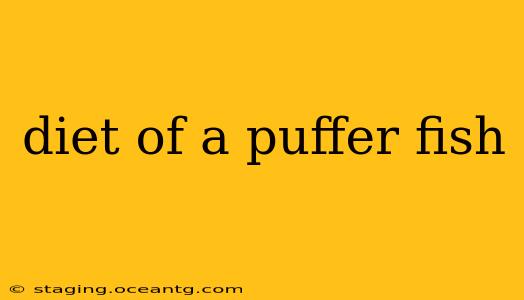Puffer fish, with their distinctive inflatable bodies and often vibrant colors, are fascinating creatures inhabiting diverse marine and freshwater environments worldwide. But what do these seemingly docile fish actually eat? The answer is more varied than you might think. Their diet isn't a single, easily defined entity, but rather a spectrum influenced by species, age, and habitat. This comprehensive guide explores the dietary habits of puffer fish, addressing some common questions along the way.
What Do Puffer Fish Eat?
The diet of a puffer fish largely depends on its species and size. However, most puffer fish are omnivorous, meaning they consume both plant and animal matter. Smaller puffer fish often feed on smaller invertebrates like crustaceans (such as crabs, shrimps, and smaller lobsters), mollusks (like snails and clams), and various worms. As they grow, their diet can expand to include larger prey. Some larger species even incorporate algae and other plant material into their diets.
Specifically, you might find a puffer fish happily munching on:
- Crustaceans: A staple food source for many species, encompassing a wide variety of sizes and types.
- Mollusks: These shelled creatures, from tiny snails to larger clams, provide a significant source of calcium and other nutrients.
- Worms: Various polychaete worms and other benthic invertebrates are readily consumed.
- Algae: Some species, particularly larger ones, incorporate algae into their diet, adding a vegetarian component.
- Small Fish: While less common for some species, larger puffer fish are known to prey on smaller fish.
- Sea Urchins: Certain species are known to feed on sea urchins.
What Do Baby Puffer Fish Eat?
Baby puffer fish, or juveniles, typically have a diet focused on smaller, easily digestible invertebrates. Microscopic crustaceans, plankton, and small larval forms of other invertebrates are common food sources during their early stages of development. This diet provides the essential nutrients for rapid growth and development. As they mature, they gradually transition to a more diverse diet reflecting the available food sources in their environment.
What Do Pet Puffer Fish Eat?
Keeping puffer fish as pets requires careful consideration of their dietary needs. Commercial puffer fish food pellets are available, but these should be supplemented with a variety of foods to ensure a balanced diet. Appropriate additions might include:
- Frozen bloodworms: A popular and readily available food source.
- Mysis shrimp: Another excellent source of protein and nutrients.
- Small pieces of clam or mussel meat: Providing calcium and other minerals.
- Occasionally, small pieces of cooked fish or shrimp (in moderation).
Important Note: Never feed your pet puffer fish anything that hasn't been thoroughly cleaned and checked for potential parasites or toxins.
Are Puffer Fish Carnivores, Herbivores, or Omnivores?
Most puffer fish species are omnivores, incorporating both plant and animal matter into their diet. While some species may show a stronger preference for one or the other, the majority exhibit a flexible dietary pattern reflecting the available food in their environment. The dietary habits are further influenced by their size and stage of development.
How Do Puffer Fish Hunt?
Puffer fish employ different hunting strategies depending on their prey. They might use a combination of ambush tactics and quick strikes, often utilizing their beak-like mouths to efficiently crack open the shells of mollusks and crustaceans. Their strong jaws are perfectly adapted for crushing hard shells and extracting the soft tissue within.
Conclusion
The diet of a puffer fish is far from monotonous. It’s a fascinating reflection of their adaptability and the diverse range of ecological niches they occupy. Understanding their dietary needs is crucial, whether studying them in the wild or keeping them as pets. This diverse and fascinating feeding behavior highlights the complexity and wonder of these unique creatures.
